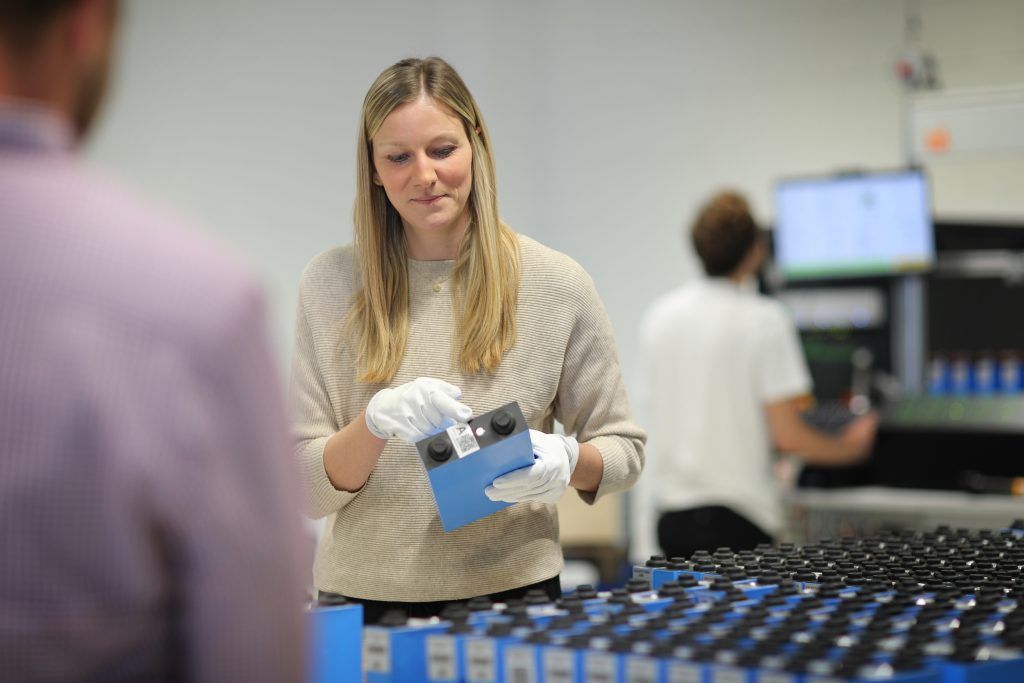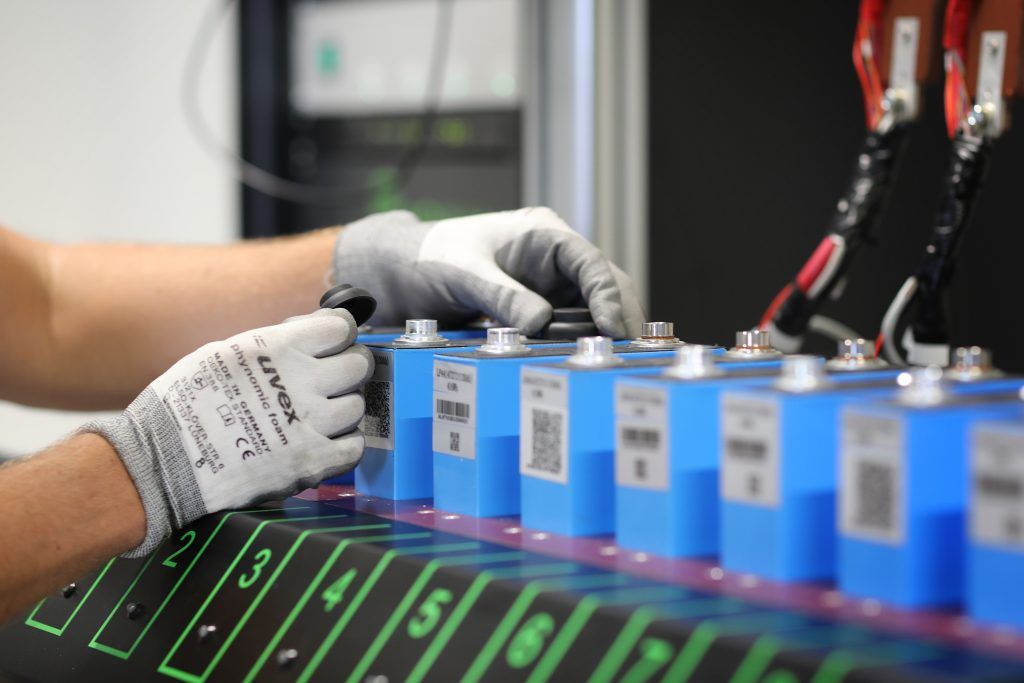A lithium-ion battery is a rechargeable energy system that uses lithium ions as the main charge carrier. With the help of NOVUM’s artificial intelligence, lithium-ion batteries can be monitored throughout their service life in order to predict problems and prevent failures or even fires. In addition, NOVUM’s stationary test systems can determine the health, capacity and residual value of lithium-ion batteries within seconds. Information on the battery history is not required. NOVUM’s technology is also suitable for lead-acid batteries and many other battery types.

Structure and function of lithium-ion batteries
Lithium-ion batteries consist of one or more electrochemical cells that are housed in a closed unit. Each cell consists of an anode (the negative pole), a cathode (the positive pole), an electrolyte that acts as a conductor between the poles and a separator that separates the anode and cathode.
During the discharging process, lithium ions move from the anode to the cathode through the separator, releasing energy. During the charging process, the lithium ions move from the cathode back to the anode, where they are stored until they are released again.
Lithium-ion batteries are used in a variety of applications, including electric vehicles, stationary battery storage and mobile devices such as smartphones and laptops, due to their high energy density and ability to store a large amount of energy in a small space.
Development of lithium-ion batteries
The development of lithium-ion batteries began in the 1970s when scientists at the University of Oxford and the University of Texas at Austin independently researched the use of lithium as a material for batteries. However, the first commercial lithium-ion batteries were not launched on the market until the 1990s.
The popularity of lithium-ion batteries has grown significantly in recent years due to the increasing demand for electronic devices and electric vehicles. Lithium-ion batteries are very attractive for use in portable devices and electric vehicles due to their high energy density and ability to be recharged quickly. They also have the advantage of being lighter and more environmentally friendly compared to other battery types such as nickel-cadmium batteries.

Advantages of lithium-ion batteries
- Lithium-ion batteries have a high energy density, which means that they can store a large amount of energy in a small space.
- Lithium-ion batteries have a high charging efficiency, which means that they can absorb a high amount of energy when they are charged.
- Lithium-ion batteries have a low self-discharge rate, which means that they can hold their charge over longer periods of time.
- Lithium-ion batteries have a relatively long lifespan compared to other battery technologies.
- Lithium-ion batteries are lightweight compared to other battery technologies, which is convenient for mobile applications.
- Lithium-ion batteries can be charged relatively quickly, making them suitable for applications such as electric vehicles
- the components of lithium-ion batteries are somewhat more environmentally friendly compared to other battery technologies, but they also contain various rare and sometimes toxic components.
Risks associated with the use of lithium-ion batteries
Like all electrochemical systems, lithium-ion batteries pose certain problems and risks — both economically and ecologically and, above all, to the health of the people who handle them.
With the help of NOVUM technology, many of these risks and problems can be minimized:
- Safety risks: Lithium-ion batteries can become unstable if overcharged, damaged or overheated and, in rare cases, explode or catch fire — both in an active state and during storage or transportation. NOVUM’s AI recognizes anomalies within seconds, which later lead to incidents so that the corresponding batteries can be replaced.
- Scarcity of raw materials: The production of lithium-ion batteries requires the continuous extraction of lithium, cobalt and other scarce raw materials. If demand increases, this can lead to problems in the supply chain. As a result, there is currently a growing demand for used lithium-ion batteries that are still intact and can be reused in a second life after being checked with NOVUM’s AI.
- Economic dependence: The demand for certain raw materials can lead to dependence on countries that pursue opposing political goals or pay little or no attention to environmental protection in the mining areas or human rights. The increasing use of second-life batteries tested with NOVUM is therefore sensible and important.
- Decreasing capacity and limited service life: As with all batteries, the properties of lithium-ion batteries deteriorate over time and after a certain number of charging cycles, which can lead to reduced performance and a shorter service life. Online monitoring with AI-based NOVUM technology allows the development of the battery to be permanently observed. This allows us to predict when it will reach a point where it has become too poor for an application and therefore needs to be replaced.
The state of health (SoH) and capacity of removed batteries and cells can be checked within seconds using NOVUM’s stationary test systems.
- Recycling and disposal: Recycling lithium-ion batteries can be complex and requires specialized equipment to recover valuable materials and avoid harmful environmental impacts. Recycling companies can check the health of batteries with NOVUM’s AI-based testing systems and put good batteries into a second application before recycling them. Safe deep discharges are also easily possible with the NOVUM Battery Analyzers.
- Environmental impact: Lithium-ion batteries contain hazardous materials, including lithium, cobalt and nickel, which have a negative impact on the environment, especially if they are not disposed of properly. The use of batteries in a second or even third and fourth life cycle is therefore particularly sustainable and sensible.
- Working conditions: Lithium is often mined in countries where child labor is still used, especially in small private mines where authorities have little control. Working conditions and pay are often poor — as is the health and safety of the workers.
It is therefore important that supply chains are transparent and that manufacturers really do ensure that no child labor or other forms of exploitation take place.
Do you want to use lithium-ion batteries as sustainably as possible? Or are you looking for solutions to recycle your batteries in a second or third life? Then we would be happy to advise you on how our AI-based test systems can support you.




